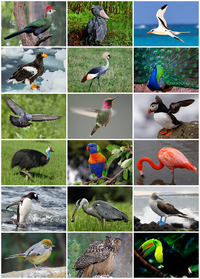
Photo from wikipedia
Ultraviolet (UV) coloration varies drastically across species and likely plays fundamentally different roles in facilitating social communication depending on the ecological or social context. While it is well known that… Click to show full abstract
Ultraviolet (UV) coloration varies drastically across species and likely plays fundamentally different roles in facilitating social communication depending on the ecological or social context. While it is well known that UV coloration serves important social functions in species that school and flock, far less is known about the role of UV coloration in group-territorial and colonial species, where individuals have long-lasting and potentially cooperative relationships with many neighbours. We measured spectral reflectance in Neolamprologus pulcher, a group-living, colonial Tanganyikan cichlid fish, and found prominent UV coloration on both sexes. We manipulated the visibility of this UV coloration using a clear UV-blocking filter or a UV-transparent filter during behavioural contests across a barrier. We found that trials between similarly sized same-sex opponents involved significantly lower frequencies of aggression when opponents' UV coloration was obscured compared to when opponents' UV coloration was visible. As aggression is typically high between similarly sized same-sex individuals in N. pulcher, this reduction in aggression suggests that UV coloration aids in motivating individuals to engage in conspecific intrasexual interactions. We found no difference in aggression in trials between familiar and unfamiliar opponents in female–female and male–female trials, regardless of the presence of UV coloration. In male–male trials, we found significantly higher frequencies of aggression in contests between familiar male opponents than in contests between unfamiliar male opponents, but only when UV coloration was visible. Collectively, these results suggest that UV coloration is important for intrasexual interactions and prompts further investigation as to the benefits of having visual signals of communication extend into the ultraviolet spectrum.
Journal Title: Animal Behaviour
Year Published: 2017
Link to full text (if available)
Share on Social Media: Sign Up to like & get
recommendations!